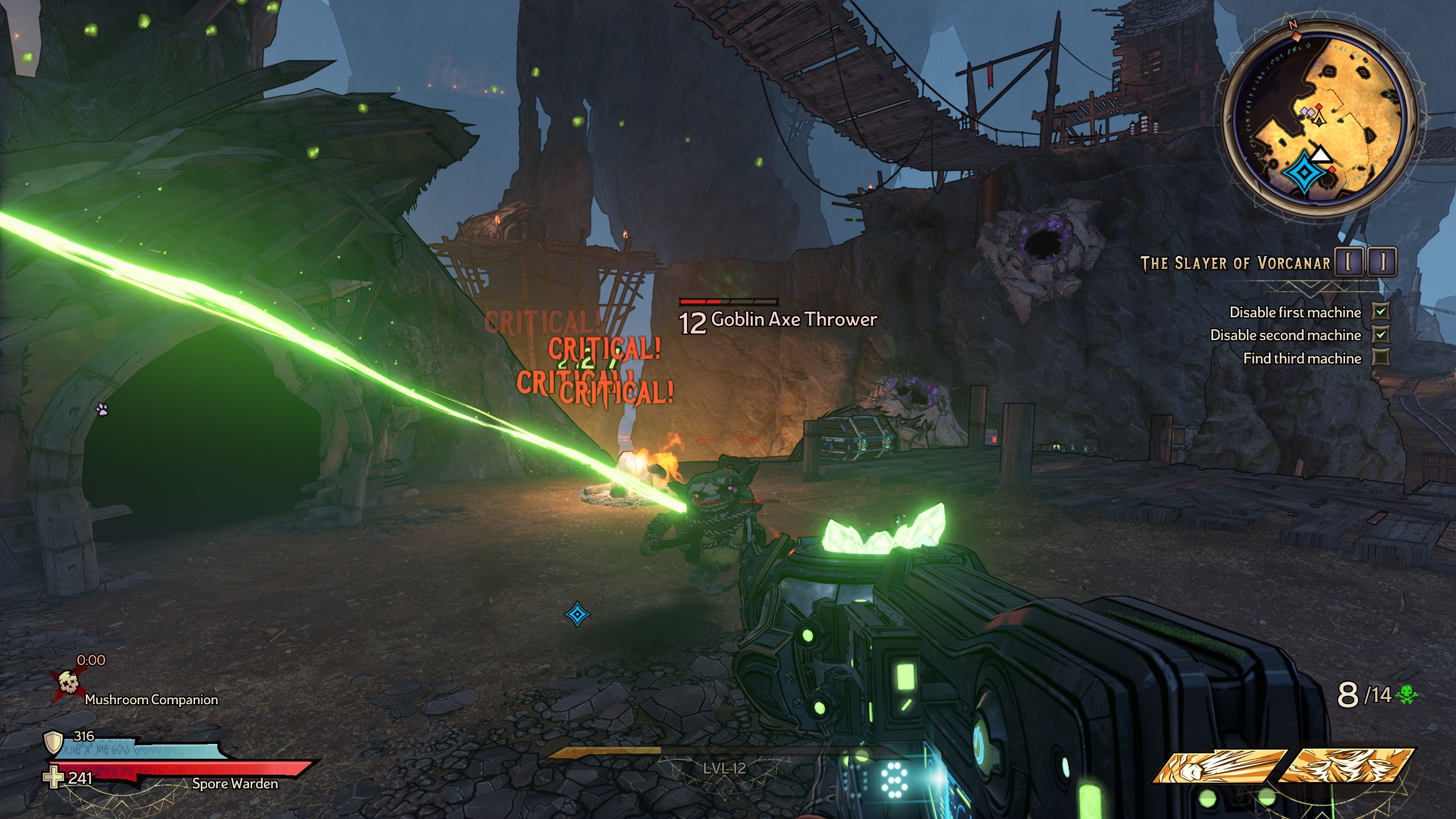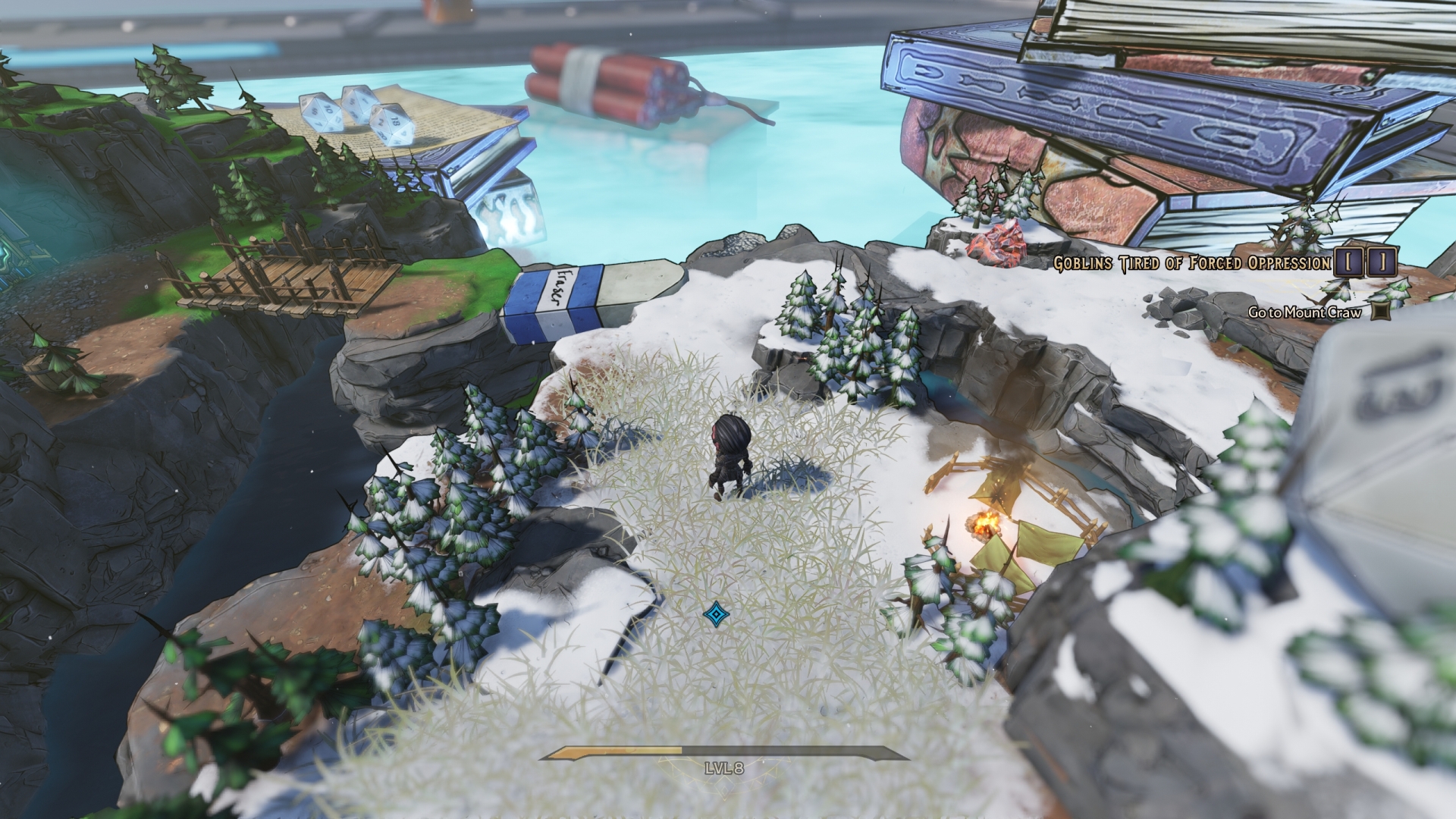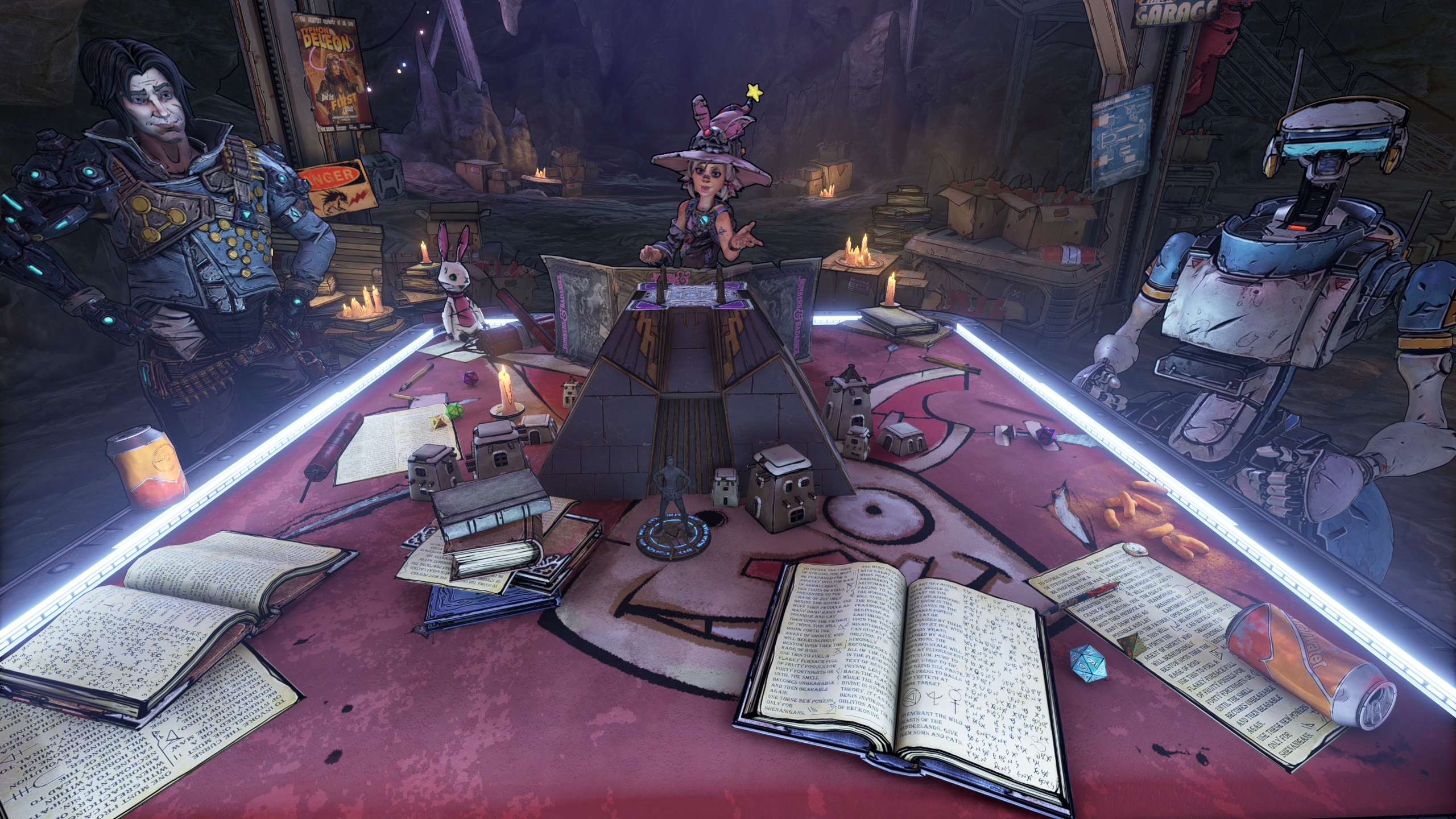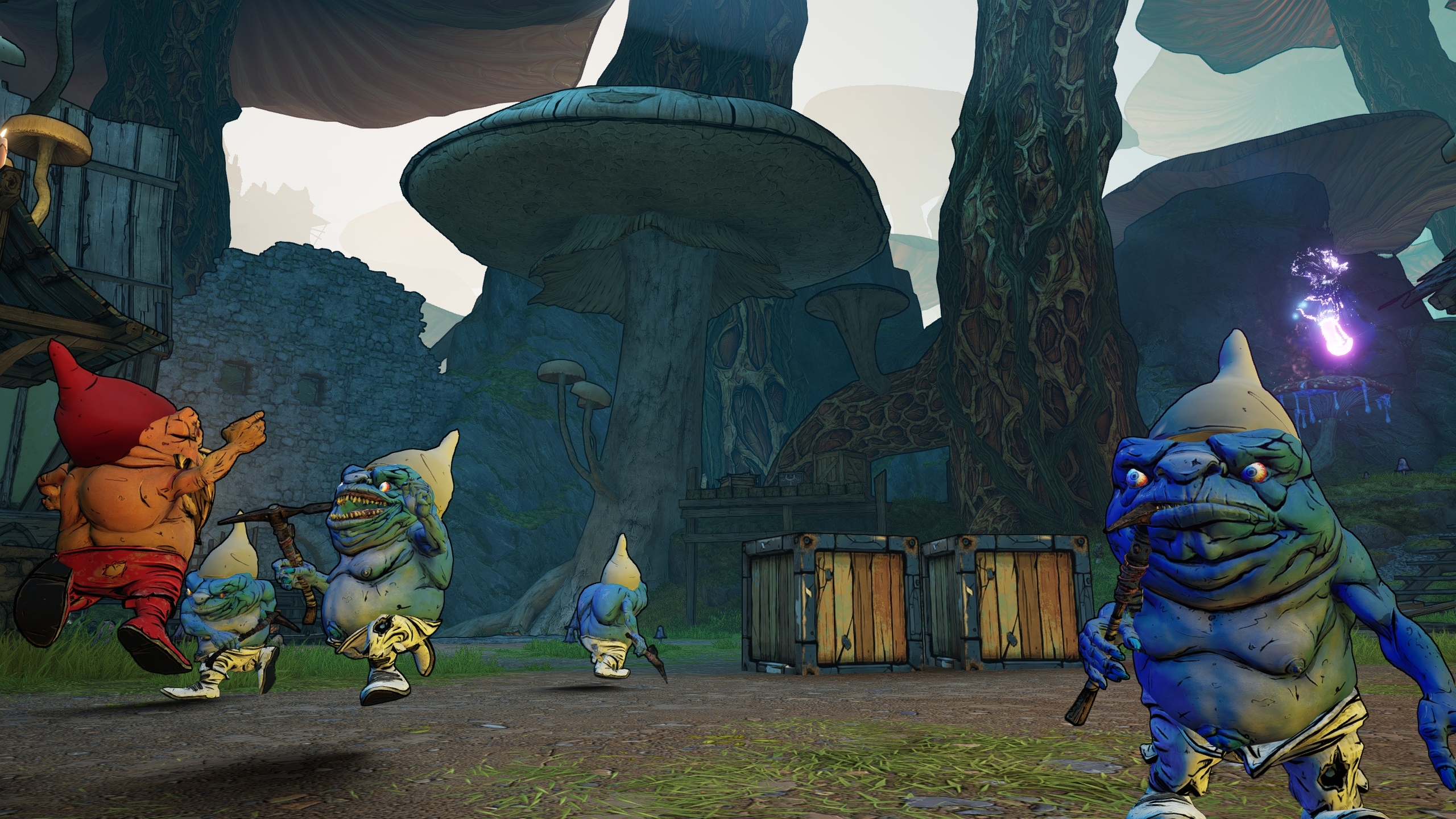Need to know
What is it? Bigger than an expansion, smaller than a standalone Borderlands game, but still very much a Gearbox banter-looter.
Release date March 25
Expect to pay $60/£60
Developer Gearbox Software
Publisher 2K Games
Reviewed on Windows 10, Ryzen 9 5900X, 32GB RAM, RTX 3080
Multiplayer? 4-player co-op
Link Official site
Tiny Tina’s Assault on Dragon Keep, the Borderlands 2 expansion that doubled as a loving parody of Dungeons & Dragons, came out in 2013. That was a year before D&D’s fifth edition revitalized interest in the game, two years before Critical Role premiered. At the time, jokes about D&D seemed pretty niche. It was a surprising move for a shooter expansion, one that paid off. It hit an untapped vein, and quickly became everyone’s favorite DLC. In 2022, though? D&D is as popular as it’s ever been, approaching cultural oversaturation, and Tiny Tina’s Wonderlands returns to a well that’s closer to running dry.
While Tiny Tina’s Wonderlands looks like a bouncy fantasy-comedy, it plays like a Borderlands game. Specifically, Borderlands 3. Some of the guns shoot crossbow bolts and the grenades have been replaced by spells, but in the moment-to-moment it’s a typical Borderlands game—you shoot hordes of bad guys who repeat pithy one-liners, then compare loot to see if the new guns and shields are better than the old ones, then do it again.

Gunderlands
Being a review of a Borderlands game, I’m obliged by law to tell you about the best guns its randomized loot pool spat out for me. A sniper rifle that fired sawblades, each of which did higher damage the more sawblades were already in a target, was a highlight. The Tediore guns that don’t need to be reloaded—instead transforming into throwable explosives then teleporting a fully-loaded replacement into your empty hands—have returned, and I got one that didn’t become an explosive but instead became a laser pixie that harassed bad guys. Another summoned hydra heads that vomited poison. Which was nice.
One significant change is character creation. Rather than each class being tied to an individual character, you play as a nameless “newbie”, building a face and color scheme and choosing a voice (you can even alter the pitch, an option I haven’t seen since Saints Row 4), and then choose any class you feel like.
I spent most of my time as a spore warden, a kind of fungal ranger with a walking mushroom pet I upgraded so he farted poison. A few of the classes get NPC allies; my co-op buddy played a grave warden who unlocked a floating skull. My mushroom companion really came into his own when I played solo, reviving me when I dropped in the absence of a co-op partner. While co-op is a chaotic good time like always, having an NPC ally makes playing alone an even more viable option, and it was already a totally satisfying way to play.
I did have to revive the friendly fungus sometimes too, which got me into trouble more than once. Though actually the worst thing about him was how distracting he was. He’d hop around in the background when quest givers were talking, his floating title MUSHROOM COMPANION appearing in big white letters visible over the NPC’s face. His unusually detailed buttocks were distracting too.

The spellshot’s class ability, being able to slot in two spells rather than one, seemed underwhelming, although when you get spells that drop ice meteors on skeletons—who take bonus frost damage because they don’t have skin to keep them warm—it’s almost worth it. But the stabbomancer being able to throw a spinning melee weapon that becomes a blade tornado you can reposition around the battlefield? That’s my current fave.
Melee weapons are a new addition, but not a game-changing one. Your regular melee attack, still mapped to V for some reason, becomes a whack with whatever sword, axe, or stick you’ve picked up. They’ve got randomized stats, though nothing as wild as the guns. Same with armor, which mostly boosts your class abilities like relics do in the mainline Borderlands games, rather than providing any actual protection.
Skill your darlings
While each class in the previous games had multiple skill trees, here they’ve only got one (though they do unlock a second active special, like the stabbomancer getting an option to turn invisible instead of throw a knife tornado). Instead, build diversity comes from multiclassing once you’ve hit higher levels, picking a second class to bolt on. My spore warden multiclassed into spellshot, becoming a sporcerer. I mostly just stuck to reliable fungus powers, though. After playing a lot of Pathfinder, the thought of having to galaxy-brain my way into overpowered class interactions ever again makes me feel ill.

Performance
On my RTX 3080, Tiny Tina’s Wonderlands ran at over 100 fps on the highest settings, though cutscenes are locked to 30 fps. The only time it stuttered was when I’d get error messages saying my connection to Shift, the network you need to sign up to for multiplayer, was down. Another message saying the connection was active would immediately follow, accompanied by a lurch. Oddly, it didn’t happen in multiplayer, but was a semi-regular occurrence when I played solo.
Like previous Borderlands games you’ll want to push the FoV up and the look sensitivity down. Weirdly, the hotspot for the left arrow on every menu slider is slightly off. You can click on the right arrows fine, but have to click sort of near but not actually on the left arrows.
One last change worth noting is the overworld map. Rather than zooming across empty spaces in vehicles, between-lands are filled by a tilt-shifted top-down tabletop covered in dice, big-headed figurines, and spilled junk food. It’s super cute, and full of side quests as well as random encounters that trigger combat arenas when you walk through the long grass.
That’s a Pokémon reference of course, but a lot of the trademark Borderlands reference-heavy humor in Tiny Tina’s Wonderlands goes for targets that aren’t RPGs. There are extended storylines that riff on the Smurfs, Don Quixote, and Monkey Island, among others. The last one’s especially baffling, since Monkey Island was pretty funny to begin with and redoing it with Guybrush Threepwood as a skeleton named Bones Three-Wood is substantially less funny.
Every now and then a bit lands with startling precision, though, usually when your advisors—two fellow players voiced by Andy Samberg and Wanda Sykes—riff on roleplaying stereotypes. They’ll be familiar to anyone who has played D&D or games like it. She’s the one who knows all the rules and how to most efficiently kill everything; he’s the one who cares about backstory and wants to solve every problem via seduction.

Sometimes it’s painfully accurate to the experience of tabletop RPGs, like when the players fixate on minor NPCs they’ve decided to distrust for arbitrary reasons while Tina fails to convince them to move on. That made me wince, but I was smiling through the pain. To its credit, and my surprise, Tiny Tina’s Wonderlands actually does find fresh angles to come at a comedy about roleplaying.
It’s funnier than Borderlands 3, that’s for sure. It helps that Will Arnett, as the Dragon Lord, makes an amusing villain. Because of course he does: He’s Will Arnett. Smug monologuing is his entire thing, and if he never quite equals Handsome Jack from Borderlands 2 that’s only because nobody will.
I went back to the Borderlands 2 DLC that inspired Tiny Tina’s Wonderlands to see how I felt about it today, and while I missed some of the quality-of-life features added by Borderlands 3 that made it into Tiny Tina’s Wonderlands—like mantling, not having to hold down E to pick up ammo, being able to fast-travel from anywhere, and only having to do side quests to be appropriately leveled for the main questline occasionally rather than all the bloody time—it was a riot.

If anything, I like it even more now. That DLC wasn’t just a bundle of jokes about the guy who throws his dice too hard or what it’s like to fumble a skill check to do something so basic you probably shouldn’t have rolled for it in the first place. It was also a fantasy retelling of Borderlands 2, the cast reimagined as knights and sorcerers like it was The Wizard of Oz. The thing it most effectively parodied was itself.
Meanwhile, Tiny Tina’s Wonderlands is largely disconnected from the Borderlands games it slots between, with only a handful of cameos (including Claptrap, sorry haters). That feels like a missed opportunity, given that Borderlands 3 was kind of a disaster, and a follow-up that took the piss out of it would have had a lot of material to work with.
It still succeeds more often than it fails, though. That’s partly just because of how the Borderlands formula has been honed over the years. While other looter-shooters bolt on crafting systems or try to make you care about gear levels and repeatable activities and collecting 15 different kinds of shards (why is it always shards?), Tiny Tina’s Wonderlands is simply another game of shooting bad guys with ridiculous guns so you can take even more ridiculous guns off their corpses. And sometimes, in-between that, it delivers a gag about what a mess the average game of D&D is that hits me like a knife in the heart.

